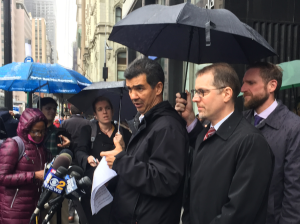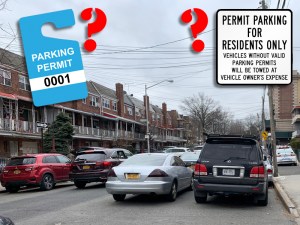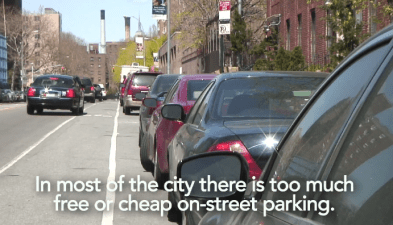Council Committee Endorses Residential Parking Permits Over DOT Objections

A City Council committee took the first step toward bringing residential parking permits to New York City neighborhoods this afternoon. Details haven’t been worked out yet, but committee members signaled their desire to move forward on a system that would restrict a portion of curbside parking space to use by local residents.
While most council members wanted to see residential parking permits brought to neighborhoods across the city, the Department of Transportation opposed RPP except perhaps in the areas immediately around stadiums.
The action in the City Council today marked an early milestone in what would be a complicated path to passage. The State and Federal Legislation Committee, chaired by Council Member Helen Foster, passed a home rule resolution allowing state legislation sponsored by State Senator Daniel Squadron and Assembly Member Joan Millman to move forward. If passed, the Squadron/Millman bill would then authorize New York City to set up its own RPP program with a few restrictions. The city would still have to work out the details and pass an actual program.
The Bloomberg administration opposed the first step in that process today, testifying against the home rule amendment and the Squadron/Millman bill. While the administration had put forward an RPP system during the push for congestion pricing in 2008, today officials said that a citywide RPP program wouldn’t be worth the trouble if it’s decoupled from road pricing. Council members, meanwhile, expressed high expectations for how RPP might alleviate the traffic and parking woes in their districts.
Foster, the bill’s sponsor, argued that her district needs RPPs are needed in her district, which is just a block from Yankee Stadium. On game days, she said, Yankee fans’ parked cars block residents from finding a parking space in their own neighborhood or even being able to walk safely. Foster said cars can regularly be found on the sidewalk and in front of hydrants during home games. Fans fill up the on-street spaces despite the thousands of empty spaces in the city-subsidized Yankee Stadium parking system. “If I could park on the sidewalk, why would I pay $45 to park in a garage?” asked Foster.
Almost every council member in attendance supported the RPP concept. Parking permits are “a long time coming,” said Stephen Levin, who noted that his Downtown Brooklyn constituents had been clamoring for an RPP program for years. The district has “a real danger with cars driving around looking for a space,” he added. Letitia James, whose district includes the Atlantic Yards site, said that RPPs would ease congestion, protect pedestrians and reduce air pollution. James Vacca, the East Bronx-based transportation committee chair, said that parking permits would encourage the use of mass transit, “which is what we want in this city.” Brad Lander called RPP “the one piece of public policy that can make a difference” on Atlantic Yards traffic.
DOT representatives disagreed, arguing that RPPs should be limited to the area immediately surrounding stadiums, if put in place at all. “Where RPP has worked, it has generally been in cities with low densities and less demand for curb parking,” argued DOT Deputy Commissioner for External Affairs David Woloch. In New York City, he said, RPPs would have “enormous potential for unintended consequences.” Because New York City has so many cars and so little on-street parking, Woloch said residents would purchase permits but still have no guarantee of finding a parking space. He also said that in other cities with RPP programs, such as Boston, Chicago and Washington, D.C., the cost of administering the program exceeds the revenues.
Woloch’s critiques included both concerns with the concept and implementation of RPPs. He argued that an opt-in system would create “a sense of exclusion between adjacent neighborhoods.” And he said that striking the right balances in setting the boundaries of RPP zones would be too difficult. He also took issue with some of the specific provisions of Squadron and Millman’s bill. The legislators want to use the proceeds of the RPP program to help fund transit, for example, but Woloch argued that would saddle the city with implementation costs without any offsetting revenues.
That said, NYC DOT is in the process of completing studies on the use of RPPs within half a mile of Yankee Stadium and the new Barclays Center at Atlantic Yards, two locations with some of the most insistent calls for permits. “DOT does believe that the benefits of RPP may be worth the costs in areas with a very large trip generator,” said Woloch. The studies are set to be completed early next year.
Most Council Members did not want to limit RPPs to stadium areas, however. Upper Manhattan rep Robert Jackson said that his district merited inclusion in any RPP system due to the large number of commuters coming off the George Washington Bridge. “They drive in across the bridge and park there all day long,” said Jackson. “Stadiums are not the only concern.” Elizabeth Crowley, too, said that her neighborhood could use a permit system despite the lack of sports arenas.
Woloch said that neighborhoods like Jackson’s would have been part of the city’s RPP plan when it was paired with congestion pricing. That was different, Woloch argued, because then the city worried that neighborhoods outside the congestion pricing zone would be park-and-rides. “Not would be,” shot back Jackson. “It is.”
The only City Council Member to speak out against the proposal was southern Brooklyn rep Lew Fidler, who seemed to have forgotten about both the city’s extensive transit system and the existence of metered parking. Wealthy communities will opt into the system, Fidler argued, at which point “you might as well put a gate up around them.” He also worried that RPPs would send New York slipping down “this slope of charging people to park on the streets.”
For their part, residents testifying made clear that they didn’t expect a RPP system to guarantee them parking, contrary to the city’s argument. RPP is “a tool to reduce demand for local streets, not a guarantee of parking for local residents,” said the Prospect Heights Neighborhood Development Council’s Gib Veconi. He said that 3,000 vehicles are expected to look for free parking on residential streets during Barclays Center events and that an RPP system could discourage them from driving.
Added Jo Ann Simon, a Democratic district leader, “We want to make sure we are not completely overrun, that our children are not killed crossing the street, and that we can breathe.”
While most of those testifying came in support of the RPP concept, some disagreed. “Our church members come from all five boroughs” said Antonio Rodriguez, representing Downtown Brooklyn’s First Baptist church. A residential permit parking system, he said “would unfairly discriminate against our church” and interfere with what he called their First Amendment right to free worship.



